Last updated: August 7, 2025
Article
Climate and Water Monitoring at Carlsbad Caverns National Park: Water Year 2023

NPS
Overview
Together, climate and hydrology shape ecosystems and the services they provide, particularly in arid and semi-arid ecosystems. Understanding changes in climate, groundwater, and surface water is key to assessing the condition of park natural resources—and often, cultural resources.
At Carlsbad Caverns National Park (Figure 1), Chihuahuan Desert Inventory and Monitoring Network scientists study how ecosystems may be changing by taking measurements of key resources, or “vital signs,” year after year—much as a doctor keeps track of a patient’s vital signs. This long-term ecological monitoring provides early warning of potential problems, allowing managers to mitigate them before they become worse. At Carlsbad Caverns National Park, we monitor climate and springs, among other vital signs.
Surface water and groundwater conditions are closely related to climate conditions. Because they are better understood together, we report on climate in conjunction with water resources. Reporting is by water year (WY), which begins in October of the previous calendar year and goes through September of the water year (e.g., WY2023 runs from October 2022 through September 2023). This web report presents the results of climate and water monitoring at Carlsbad Caverns National Park in WY2023.
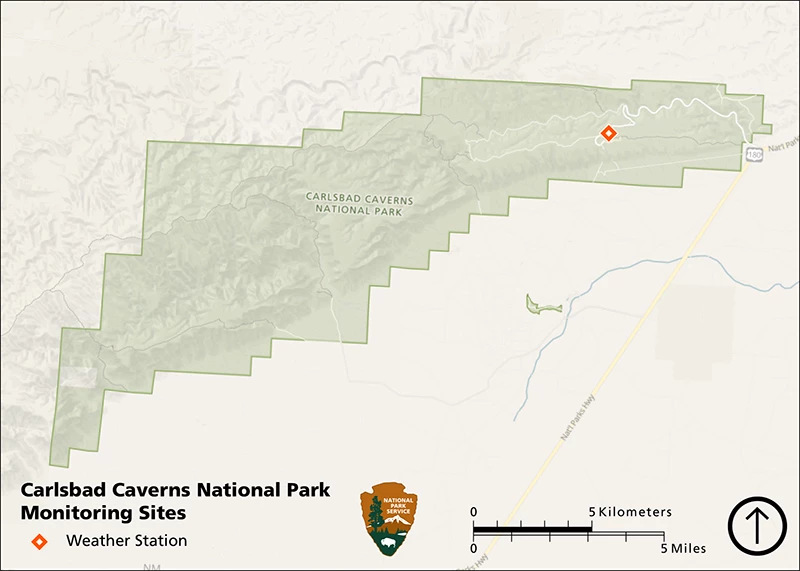
NPS
Climate and Weather
There is often confusion over the terms “weather” and “climate.” In short, weather describes instantaneous meteorological conditions (e.g., it’s currently raining or snowing, it’s a hot or frigid day), and climate reflects patterns of weather at a given place over longer periods of time (seasons to years). Climate is the primary driver of ecological processes on Earth. Climate and weather information provide context for understanding the status or condition of other park resources.
Methods
A National Oceanic and Atmospheric Administration Cooperative Observer Program (NOAA COOP) weather station (Carlsbad Caverns #291480) has been operational at Carlsbad Caverns National Park since 1935 (Figure 1). This station typically provides a reliable climate dataset. However, in WY2023 the station was missing data for 54 days. As a substitute, climate analyses in this report use current year and 30-year averages (1991–2020) of gridded surface meteorological (GRIDMET) data from the location of the station near the visitor center. Subsequent reports may revert to the COOP weather station as the data source depending on future data quality.
GRIDMET is a spatial climate dataset at a 4-kilometer resolution that is interpolated using weather station data, topography, and other observational and modeled land surface data. Temperature and precipitation estimated from GRIDMET may vary from actual weather at a particular location depending on the availability of weather station data and the difference in elevation between the location of interest and that assigned to a grid cell. Data from both weather station and GRIDMET are accessible through Climate Analyzer.
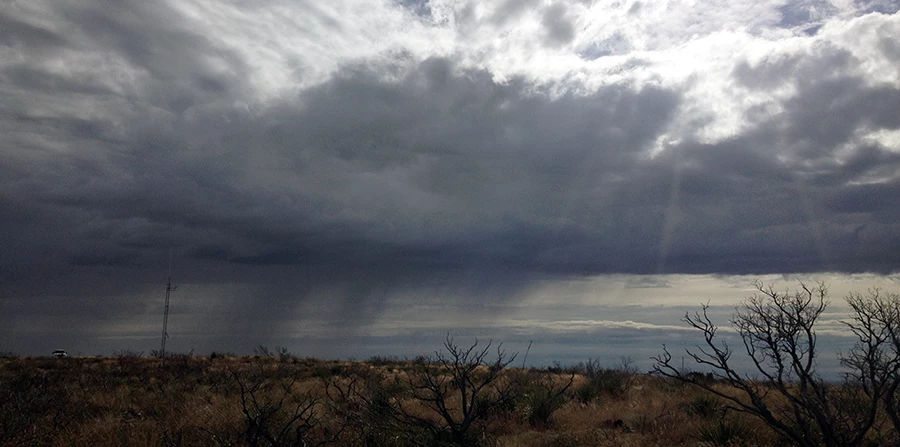
NPS
Results
Precipitation
Annual precipitation at Carlsbad Caverns National Park in WY2023 was 9.02″ (22.9 cm), 5.69″ (14.5 cm) less than the 1991–2020 annual average. The precipitation for the cool season of WY2023 (October–March) was 4.18″ (10.6 cm), a slight surplus of 0.36″ (0.9 cm) compared to the 1991–2020 average. October received over twice the 1991–2020 average precipitation (Figure 2). The precipitation total for the warm season (April–September) was 4.82″ (12.2 cm), a large deficit of 6.08″ (15.4 cm) compared to the 1991–2020 average.
Air temperature
The mean annual maximum temperature at Carlsbad Caverns National Park in WY2023 was 75.9°F (24.4°C), 0.3°F (0.2°C) above the 1991–2020 average. The mean annual minimum temperature in WY2023 was 53.6°F (12.0°C), 2.4°F (1.4°C) above the 1991–2020 average. Mean monthly maximum and minimum temperatures in WY2023 differed by as much as 7.8°F (4.3°C; see September as an example) relative to the 1991–2020 monthly averages (Figure 2). During the first part of the year (October–May) monthly mean maximum and minimum temperatures were variable relative to the 1991–2020 monthly averages. Elevated warming occurred during the latter part of the water year (June–September).
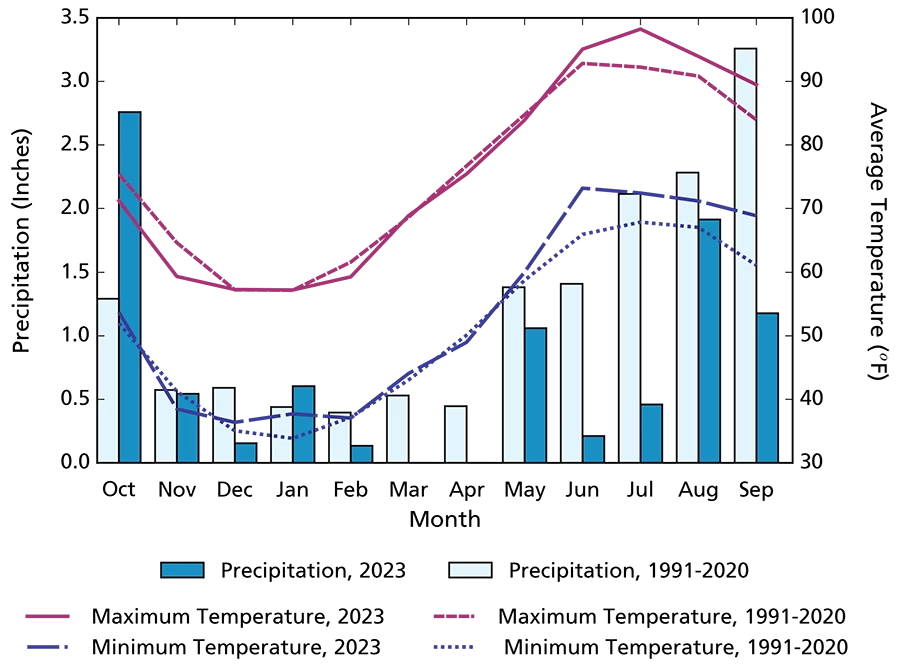
NPS
Drought
Reconnaissance drought index (Tsakiris and Vangelis 2005) provides a measure of drought severity and extent relative to the long-term climate. It is based on the ratio of average precipitation to average potential evapotranspiration (the amount of water loss that would occur from evaporation and plant transpiration if the water supply was unlimited) over short periods of time (seasons to years). The reconnaissance drought index for Carlsbad Caverns National Park indicates that WY2023 was drier than the 1991–2023 average from the perspective of both precipitation and potential evapotranspiration (Figure 3).
Reference: Tsakiris G., and H. Vangelis. 2005. Establishing a drought index incorporating evapotranspiration. European Water 9: 3–11.
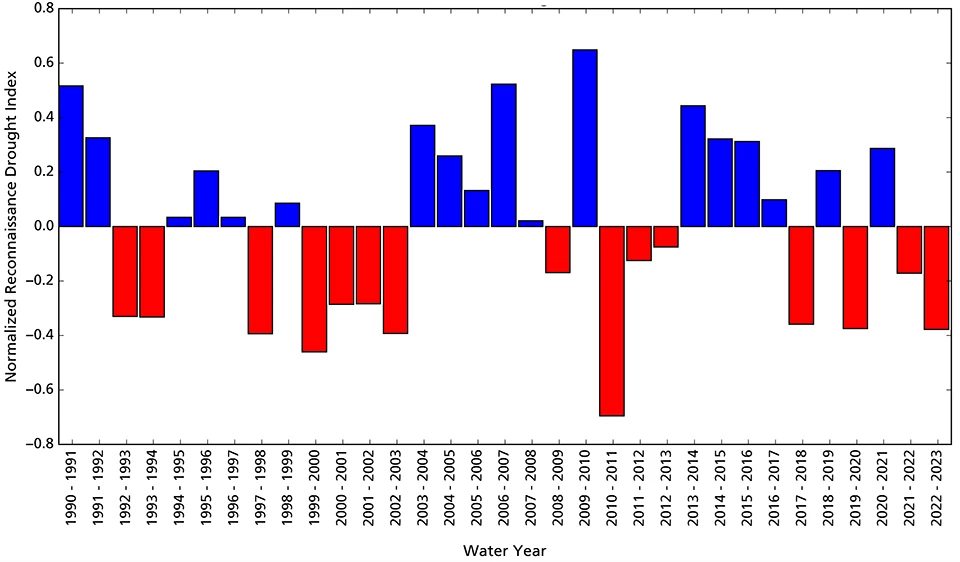
NPS
Springs
Background
Springs, seeps, and tinajas (discrete pools in a rock basin or impoundments in bedrock) are small, relatively rare biodiversity hotspots in arid lands. They are the primary connection between groundwater and surface water and are important water sources for plants and animals. For springs, the most important questions we ask are about persistence (How long was there water in the spring?) and water quantity (How much water was in the spring?). Springs reporting is by water year (WY), which begins in October of the previous calendar year and goes through September of the current calendar year (e.g., WY2023 runs from October 2022 through September 2023). WY2023 springs sampling at Carlsbad Caverns National Park occurred between 04 March and 07 March 2023. Water persistence is monitored continuously throughout the water year, but in this report we only present WY2023 persistence data up to the springs sampling visit date.
Methods
Chihuahuan Desert Network springs monitoring is organized into the four modules described below.
Site Characterization
This module provides context for interpreting change in the other modules. We record GPS locations, draw a site diagram, and describe the spring type (e.g., helocrene, limnocrene, rheocrene, or tinaja) and its associated vegetation in this module. Helocrene springs emerge as low-gradient wetlands, limnocrene springs emerge as pools, and rheocrene springs emerge as flowing streams. This module is completed once every five years or after significant events.
Site Condition
We estimate the level of natural and anthropogenic disturbances and the level of stress on vegetation and soils at the spring on a scale of 1–4, where 1 = undisturbed, 2 = slightly disturbed, 3 = moderately disturbed, and 4 = highly disturbed. Types of natural disturbances can include flooding, drying, fire, wildlife impacts, windthrow of trees and shrubs, beaver activity, and insect infestations. Anthropogenic disturbances can include roads, off-highway vehicle trails, hiking trails, livestock and feral-animal impacts, removal of invasive non-native plants, flow modification, and other evidence of human use of the spring site. We take repeat photographs from the same location and perspective to show the spring and its landscape context. We note the presence of certain obligate wetland plant species (plant species that almost always occur only in wetlands), facultative wetland plant species (plant species that usually occur in wetlands but also occur in other habitats), and invasive non-native crayfish and bullfrogs (American bullfrog [Lithobates catesbeianus]). We also record the density of invasive non-native plants using a qualitative scale (1–5 plants, scattered patches, evenly distributed patches, or a matrix).
Water Quantity
We measure the persistence of surface water, amount of spring discharge, and wetted extent (area that contained water). To estimate persistence, we analyze the variance of temperature measurements taken by logging thermometers placed at or near the orifice (spring opening). Because water mediates variation in diurnal temperatures, data from a submerged sensor will show less daily variation than data from an exposed, open-air sensor; this tells us when the spring was wet or dry. Surface discharge is measured with a timed sample of water volume. Wetted extent is a systematic measurement of the physical length (up to 100 m), width, and depth of surface water. It is assessed using a technique for either standing water (e.g., limnocrene and helocrene springs) or flowing water (e.g., rheocrene springs).
Water Quality
We measure core water quality and water chemistry parameters. Core water quality parameters include water temperature, pH, specific conductivity (a measure of dissolved compounds and contaminants), dissolved oxygen (how much oxygen is present in the water), and total dissolved solids (an indicator of potentially undesirable compounds). Discrete measurements of these parameters are collected with a multiparameter meter. If the meter fails calibration checks, we do not present data. Water chemistry is assessed by collecting surface water sample(s) and estimating the concentration of major ions with a photometer in the field. These parameters are collected at one or more sampling locations within a spring. Data are presented only for the primary sampling location within each spring. Each perennial spring is somewhat unique, and New Mexico has not adopted water quality standards that would apply across the diversity of springs described here. Ongoing, long-term data collection at each spring will improve our understanding of the natural range in water quality and water chemistry parameters for a given site.
List of Springs
Scroll down or click on a spring below to view monitoring results.
Iron Pipe Seep ǀ Oak Spring ǀ Slaughter Pot Hole ǀ Upper East Grammer Spring ǀ Upper Lechuguilla Spring ǀ Upper Lowe Ranch Spring
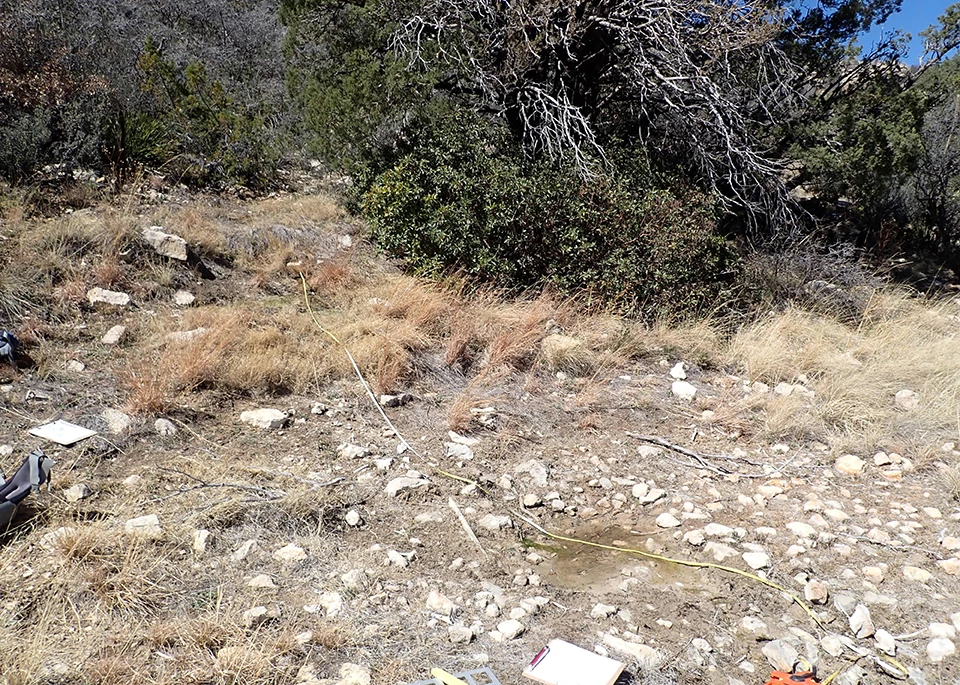
NPS
Iron Pipe Seep
Iron Pipe Seep (Figure 4) is a rheocrene spring (a spring that emerges into one or more stream channels) located at high elevation below a rock outcrop on an east-facing ridge overlooking West Slaughter Canyon. Cool, clear water trickles from a historical 1-inch-diameter pipe, protruding a few inches out from the hillside. It forms an intermittent channel that has measured up to 7.3 m in length. Grasses, shrubs and junipers dot the area immediately surrounding the spring. The WY2023 visit occurred on 04 March 2023, and the spring was wetted (contained water).
Site Condition
In WY2023, Iron Pipe Seep was rated slightly disturbed by drying since the spring contained less wetted area and a previously wetted pool was dry (rated undisturbed to moderately disturbed in the past); slightly disturbed by wildlife because of tracks and scat (rated undisturbed to moderately disturbed in the past); and moderately disturbed by flow modification because the iron pipe directs spring flow (rated undisturbed to highly disturbed in the past). No other natural or human-caused disturbances were observed at Iron Pipe Seep in WY2023.
As in past years, we did not observe invasive non-native crayfish or American bullfrog (Lithobates catesbeianus) at Iron Pipe Seep in WY2023, nor did we observe any invasive non-native plants.
We observed two species of obligate/facultative wetland plants at Iron Pipe Seep in WY2023: rushes (Juncaceae, observed in 2018 and 2022); and sedges (Cyperaceae, observed in 2017–2021).
Water Quantity
Sensors are deployed and data are downloaded during our annual visit, which takes place in the middle of the water year; the dates of these visits are indicated by black diamonds in the persistence graph (Figure 5).The temperature sensor indicated that Iron Pipe Seep was wetted for 155 of 155 days (100%) measured. In prior water years, the spring was wetted 6.1–72.9% of the days measured across entire water years.
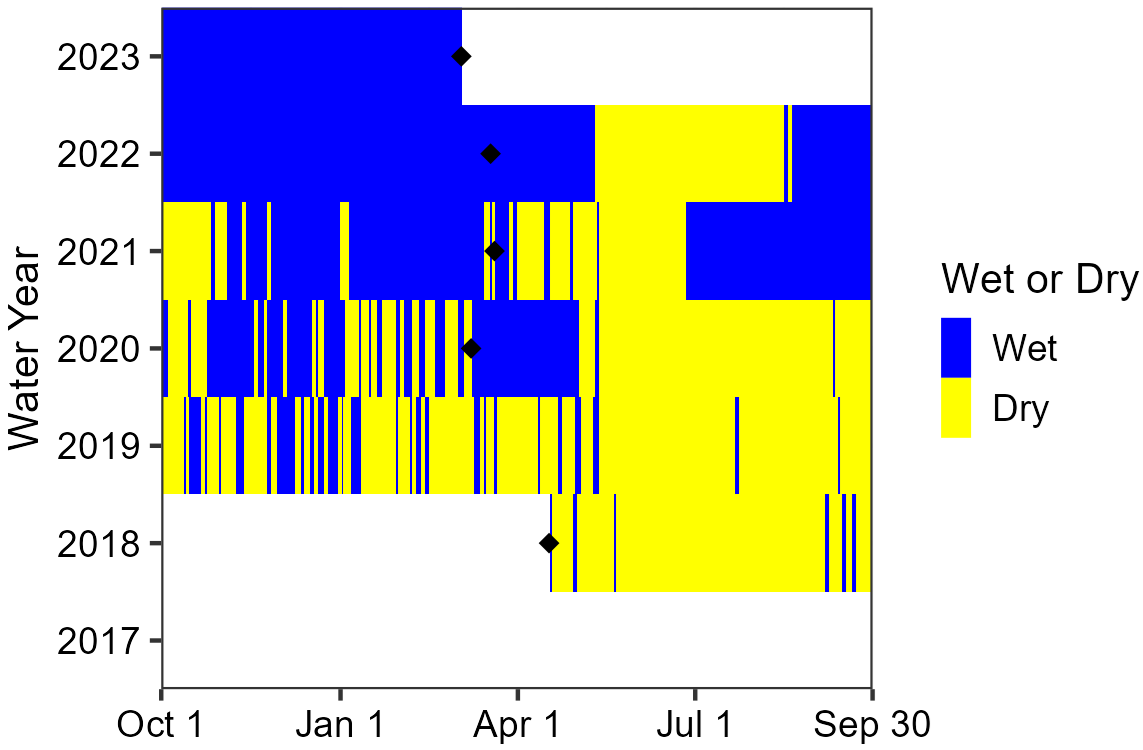
NPS
Discharge was estimated at 0.2 ± 0.003 L/min (0.05 ± 0.0007 gal/min) in WY2023 (Table 1). This is within the range of discharge observations in previous years.
Wetted extent was evaluated using a method for flowing water in WY2023. The total springbrook length was 6.3 m (20.7 ft). In the past, measured springbrook lengths ranged from 0.5 to 7.3 m (1.6 to 24.0 ft). Width and depth along the springbrook averaged 31.2 cm (12.3 in) and 0.7 cm (0.3 in), respectively. Length and average depth of the springbrook were within the range of past measurements, but it was wider than in prior years (Table 2).
Water Quality
Core water quality (Table 3) and water chemistry (Table 4) data were collected at the primary sampling location in WY2023, directly from the iron pipe. Dissolved oxygen and water temperature were within the ranges of previously recorded values (2018–2022), while specific conductivity and total dissolved solids were slightly lower, and pH was higher. Levels of chloride, magnesium, potassium, and sulphate were within prior value ranges, while alkalinity and calcium were lower.
Iron Pipe Seep Data Tables
| Sampling Location | WY2023 Mean (range of prior means) |
Prior Years Measured (# of visits with measurements) |
|---|---|---|
| 001 | 0.2 ± 0.003 (0.0–0.3) | 2018–2022 (5) |
| Measurement | WY2023 Value (range of prior values/means) |
Prior Years Measured (# of visits with measurements) |
|---|---|---|
| Width (cm) | 31.2 ± 47.5 (13.6–29.2) | 2018–2022 (5) |
| Depth (cm) | 0.7 ± 0.9 (0.4–0.7) | 2018–2022 (5) |
| Length (m) | 6.3 (0.5–7.3) | 2018–2022 (5) |
| Sampling Location | Measurement Location | Parameter | WY2023 Value (range of prior values) |
Prior Years Measured (# of measurements) |
|---|---|---|---|---|
| 001 | Center | Dissolved oxygen (mg/L) | 2.03 (1.71–7.35) |
2018–2022 (6) |
| 001 | Center | pH | 7.05 (6.86–6.96) |
2018–2022 (5) |
| 001 | Center | Specific conductivity (µS/cm) | 662 (668–764) |
2018–2022 (5) |
| 001 | Center | Temperature (°C) | 14.3 (13.2–19.6) |
2018–2022 (8) |
| 001 | Center | Total dissolved solids (mg/L) | 430 (434–497) |
2018–2022 (5) |
| Sampling Location | Measurement Location | Parameter | WY2023 Value (range of prior values) |
Prior Years Measured (# of measurements) |
|---|---|---|---|---|
| 001 | Center | Alkalinity (CaCO3) |
285 (320–390) |
2018–2022 (5) |
| 001 | Center | Calcium (Ca) |
18 (50–56) |
2018–2022 (5) |
| 001 | Center | Chloride (Cl) |
8 (5–61) |
2018–2022 (5) |
| 001 | Center | Magnesium (Mg) |
60 (48–90) |
2018–2022 (5) |
| 001 | Center | Potassium (K) |
0.3 (0.1–1.6) |
2018–2022 (5) |
| 001 | Center | Sulphate (SO4) |
8 (3–9) |
2018–2022 (5) |
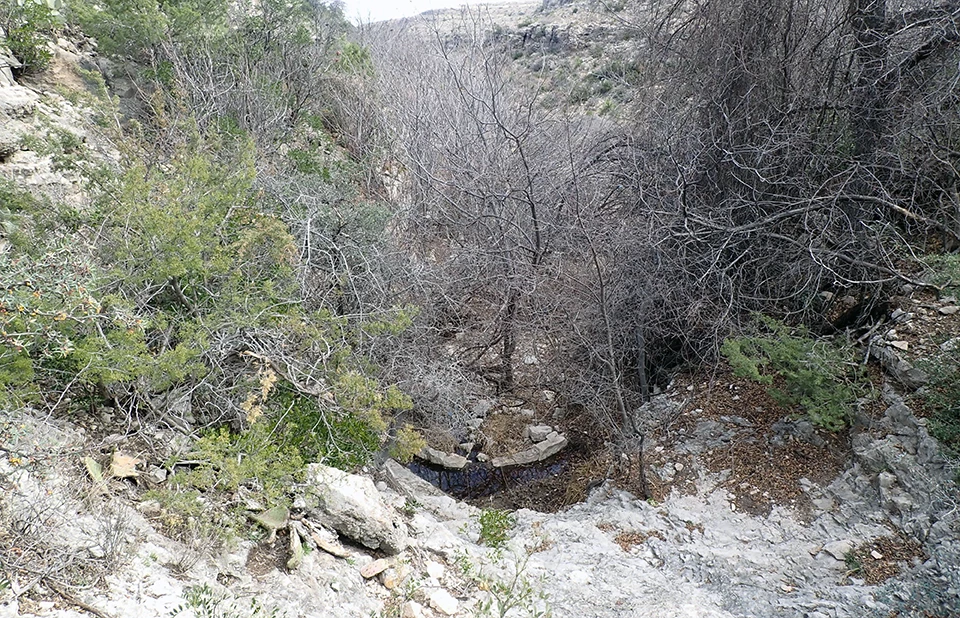
NPS
Oak Spring
Oak Spring (Figure 6) is a rheocrene spring (a spring that emerges into one or more stream channels) originating from several distinct orifices in an east-facing drainage lined with oak and juniper, about 1 km northwest of the Carlsbad Caverns Visitor Center. The primary orifice seeps cool, clear water from a bedrock seam inside the drainage, where a man-made rock dam confines the flow into a crescent-shaped pool. Additional seeps produce flow along the bedrock walls in the drainage and contribute to a plunge pool further down the channel. The WY2023 visit occurred on 05 March 2023, and the spring was wetted (contained water).
Site Condition
In WY2023, we rated Oak Spring slightly disturbed by flow modification related to rock walls, dams, and pipes (rated undisturbed to highly disturbed in the past) and slightly disturbed by recent flooding, with new rocks and sediment deposition in the plunge pool and flood debris and wrack—all limited to the lower reaches of the channel (rated undisturbed to slightly disturbed by recent flooding in the past). The spring was slightly disturbed by fire with charred stumps from a past fire in the vicinity (rated undisturbed to slightly disturbed in the past); slightly disturbed by wildlife because of ungulate tracks and trails, bedding areas, and scat (rated slightly to moderately disturbed in the past); and moderately disturbed by drying based on stress and decline of wetland plants in the riparian area, including the cattail (Typha sp.) population. No other natural or human-caused disturbances were observed at Oak Spring in WY2023.
As in past years, we did not observe any invasive non-native crayfish or American bullfrog (Lithobates catesbeianus) at Oak Spring in WY2023. We observed three species of invasive non-native plants: evenly distributed patches of bermudagrass (Cynodon dactylon; matrix observed in 2017–2022); scattered patches of horehound (Marrubium vulgare; scattered patches to evenly distributed patches observed in 2017–2022); and scattered patches of Johnsongrass (Sorghum halepense; scattered patches observed in 2022).
We observed four species of obligate/facultative wetland plants at Oak Spring in WY2023: maidenhair fern (Adiantum sp., a fern observed in 2018–2020); rushes (Juncaceae, observed in 2019–2022; and a sedge (Carex sp., observed in 2018–2022). Cattails (Typha sp.) were also observed but appeared to be dead or dormant.
Water Quantity
Sensors are deployed and data are downloaded during our annual visit, which takes place in the middle of the water year; the dates of these visits are indicated by black diamonds in the persistence graph (Figure 7). Temperature sensor data are missing because of a sensor malfunction, so there is no estimate of persistence for WY2023. In prior water years, the spring was wetted 77.5–100% of the days measured across entire water years.
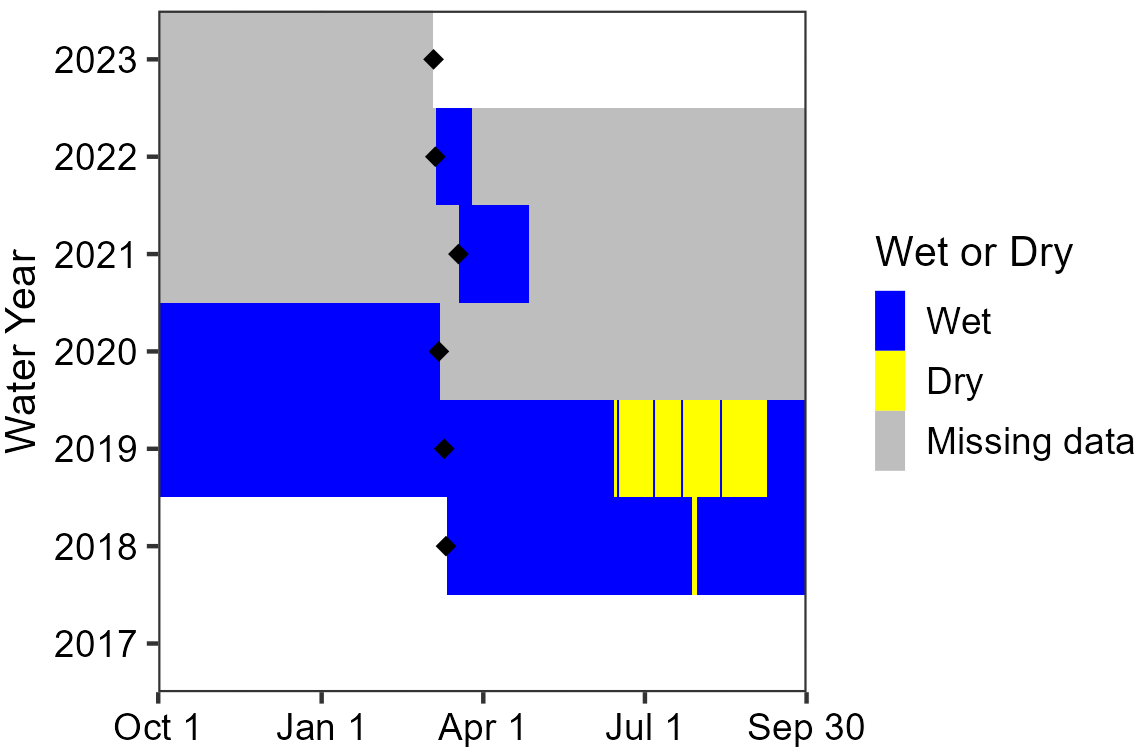
NPS
Discharge was not measured in WY2023 because of a lack of measurable surface flow at the primary sampling location. Discharge estimates from 2018 and 2019 are presented in Table 5. Wetted extent was evaluated using a method for flowing water. The total springbrook length was 12.1 m (39.7 ft) in WY2023. In the past, measured springbrook lengths ranged from 10.9 to 43.6 m (35.8 to 143.0 ft). Width and depth averaged 32 cm (12.6 in) and 1.4 cm (0.6 in), respectively. These measurements were similar in previous years (2018–2022, Table 6).
Water Quality
Core water quality (Table 7) and water chemistry (Table 8) data were collected at the primary sampling location in the pool near the primary orifice. Values for dissolved oxygen, pH, specific conductivity, and total dissolved solids were within the ranges of values recorded in prior years (2018–2022), while water temperature was slightly lower. Calcium, magnesium, and potassium levels were within the ranges of previous measurements (2018–2022), while alkalinity, chloride, and sulphate levels were slightly lower.
Oak Spring Data Tables
| Sampling Location | WY2023 Mean (range of prior means) |
Prior Years Measured (# of visits with measurements) |
|---|---|---|
| 004 | c.n.s. (0.4–0.6) | 2018–2019 (2) |
| Measurement | WY2023 Value (range of prior values/means) |
Prior Years Measured (# of visits with measurements) |
|---|---|---|
| Width (cm) | 32.0 ± 34.9 (26.4–64.5) | 2018–2022 (5) |
| Depth (cm) | 1.4 ± 1.4 (0.4–2.1) | 2018–2022 (5) |
| Length (m) | 12.1 (10.9–43.6) | 2018–2022 (5) |
| Sampling Location | Measurement Location | Parameter | WY2023 Value (range of prior values) |
Prior Years Measured (# of measurements) |
|---|---|---|---|---|
| 001 | Center | Dissolved oxygen (mg/L) | 6.32 (4.64–8.02) |
2019–2022 (5) |
| 001 | Center | pH | 7.93 (7.75–8.12) |
2018–2022 (5) |
| 001 | Center | Specific conductivity (µS/cm) | 541.0 (525.0–594.8) |
2018–2022 (5) |
| 001 | Center | Temperature (°C) | 8.7 (10.4–15.8) |
2018–2022 (5) |
| 001 | Center | Total dissolved solids (mg/L) | 352 (342–389) |
2018–2022 (5) |
| Sampling Location | Measurement Location | Parameter | WY2023 Value (range of prior values) |
Prior Years Measured (# of measurements) |
|---|---|---|---|---|
| 001 | Center | Alkalinity (CaCO3) |
250 (255–270) |
2018–2022 (5) |
| 001 | Center | Calcium (Ca) |
64 (46–64) |
2018–2022 (5) |
| 001 | Center | Chloride (Cl) |
2 (5–31) |
2018–2022 (5) |
| 001 | Center | Magnesium (Mg) |
44 (0–65) |
2018–2022 (5) |
| 001 | Center | Potassium (K) |
0.9 (0.5–1.7) |
2018–2022 (5) |
| 001 | Center | Sulphate (SO4) |
0 (2–21) |
2018–2022 (5) |
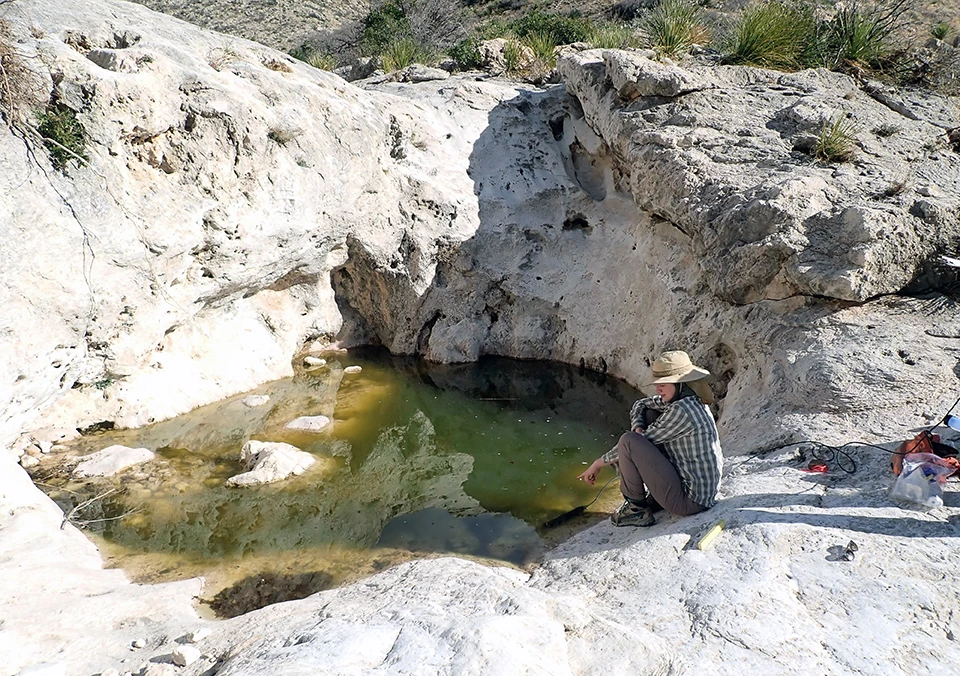
NPS
Slaughter Pot Hole
Slaughter Pot Hole (Figure 8) is a tinaja (a small pool in a rock basin or impoundment in bedrock) located in the upper elevations of Slaughter Canyon. The north, east, and west sides of the pool have sloping, slickrock walls, and the southwest side has a gentler slope that opens to a dry cobblestone wash where the Slaughter Canyon Trail passes through. The WY2023 visit occurred on 07 March 2023, and the tinaja was wetted (contained water).
Site Condition
In WY2023, we rated Slaughter Pot Hole slightly disturbed by hiking trails, with the Slaughter Canyon Trail close to the tinaja, but anthropogenic impact appears minimal (rated slightly to moderately disturbed in the past); slightly disturbed by feral animals based on scat and tracks that are likely from Barbary sheep (rated undisturbed to slightly disturbed in the past); and slightly disturbed by recent flooding (rated undisturbed to slightly disturbed in the past). There was debris and scouring in the canyon from a recent flood, and our water sensor stake was missing, likely washed out in a flood event. No other natural or human-caused disturbances were observed at Slaughter Pot Hole in WY2023.
As in past years, we did not observe any invasive non-native crayfish or American bullfrog (Lithobates catesbeianus) at Slaughter Pot Hole in WY2023, nor did we observe any invasive non-native plants.
Consistent with prior years, we did not observe any obligate/facultative wetland plants at Slaughter Pot Hole in WY2023.
Water Quantity
Sensors are deployed and data are downloaded during our annual visit, which takes place in the middle of the water year; the dates of these visits are indicated by black diamonds in the persistence graph (Figure 9). Temperature sensor data are missing due to the loss of the sensor and its attachment stake at the site, so there is no estimate of persistence for WY2023. In prior water years, the spring was wetted 46.2–100% of the days measured across entire water years.
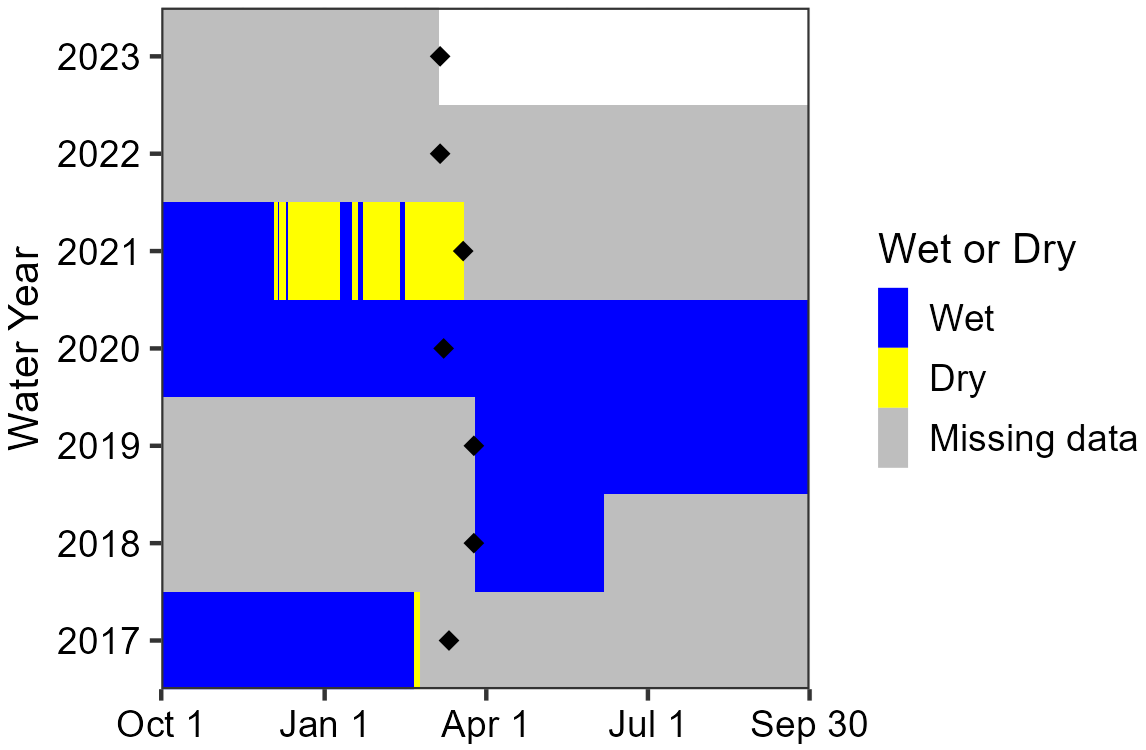
NPS
As in past years, there was no measurable discharge from the tinaja.
Wetted extent was evaluated using a method for standing water. Width averaged 4.0 m (13.1 ft), length averaged 4.5 m (14.8 ft), and depth averaged 109.5 cm (43.1 in). In WY2023, average width, depth, and length of the tinaja were greater than any prior measurements in the last six years (Table 9).
Water Quality
Core water quality (Table 10) and water chemistry (Table 11) data were collected at the primary sampling location at the southeast edge of the pool. Values for dissolved oxygen, pH, specific conductivity, water temperature, and total dissolved solids were all within the ranges of values recorded in prior years. Alkalinity, calcium, chloride, and sulphate levels were within the ranges of previous measurements, while magnesium was slightly higher and potassium was slightly lower.
Slaughter Pot Hole Data Tables
| Measurement | WY2023 Mean (range of prior means) |
Prior Years Measured (# of visits with measurements) |
|---|---|---|
| Width (m) | 4.0 ± 0.5 (0.6–2.7) | 2017–2022 (6) |
| Depth (cm) | 109.5 ± 70.8 (24.3–87.5) | 2017–2022 (6) |
| Length (m) | 4.5 ± 1.0 (1.0–4.2) | 2017–2022 (6) |
| Sampling Location | Measurement Location | Parameter | WY2023 Value (range of prior values) |
Prior Years Measured (# of measurements) |
|---|---|---|---|---|
| 001 | Center | Dissolved oxygen (mg/L) | 10.44 (0.56–17.40) |
2018–2022 (5) |
| 001 | Center | pH | 9.25 (8.91–9.51) |
2018–2022 (4) |
| 001 | Center | Specific conductivity (µS/cm) | 234.5 (182.4–644.0) |
2018–2022 (5) |
| 001 | Center | Temperature (°C) | 12.0 (10.6–17.0) |
2018–2022 (7) |
| 001 | Center | Total dissolved solids (mg/L) | 152 (118–419) |
2018–2022 (5) |
| Sampling Location | Measurement Location | Parameter | WY2023 Value (range of prior values) |
Prior Years Measured (# of measurements) |
|---|---|---|---|---|
| 001 | Center | Alkalinity (CaCO3) |
115 (95–350) |
2018–2022 (4) |
| 001 | Center | Calcium (Ca) |
30 (22–54) |
2018–2022 (4) |
| 001 | Center | Chloride (Cl) |
b.d.l. (b.d.l.–12) |
2018–2022 (4) |
| 001 | Center | Magnesium (Mg) |
9 (b.d.l.–7) |
2018–2022 (4) |
| 001 | Center | Potassium (K) |
2.3 (3.2–36.0) |
2018–2022 (4) |
| 001 | Center | Sulphate (SO4) |
4 (b.d.l.–6) |
2018–2022 (4) |
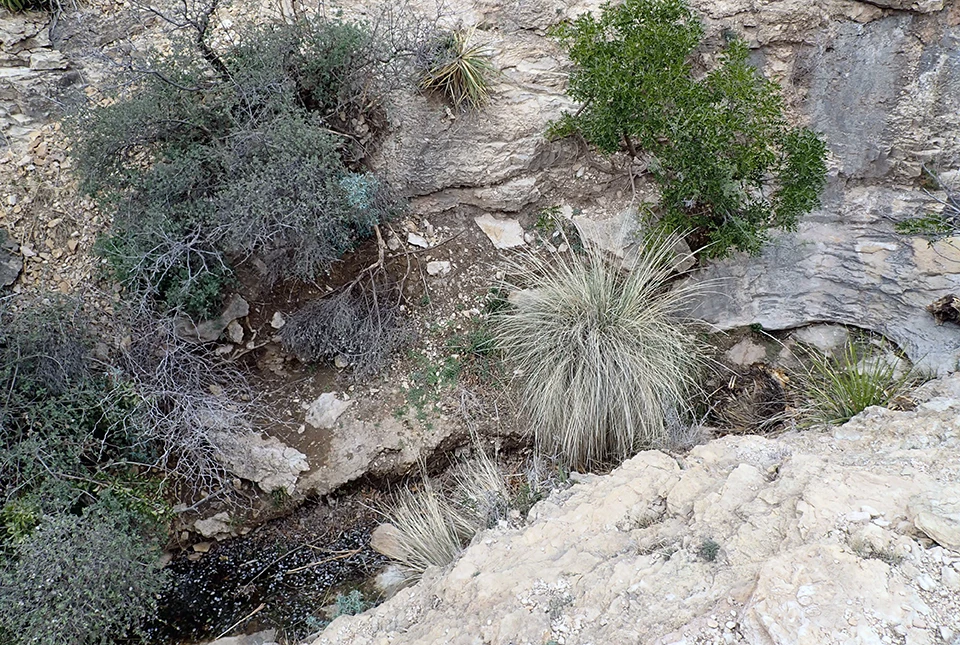
NPS
Upper East Grammer Spring
Upper East Grammer Spring (Figure 10) is a rheocrene spring (a spring that emerges into one or more stream channels) located in a south-facing side drainage of Walnut Canyon that has ranged from 16.5 to 43.5 m in length in recent years. The spring is a slow seep that emerges from a rounded limestone bedrock seam inside the rocky drainage. It forms shallow pools in shaded areas and flows subsurface intermittently. The WY2023 visit occurred on 05 March 2023 and the spring was wetted (contained water).
Site Condition
In WY2023, we rated Upper East Grammer Spring slightly disturbed by feral animals because of non-native Barbary sheep (Ammotragus lervia) scat, trails, and browsing (rated undisturbed to moderately disturbed in the past); slightly disturbed by wildlife, with tracks, game trails, and scat (rated slightly to moderately disturbed in the past); moderately disturbed by recent flooding based on flood debris deposition on much of the previously wetted area, scour, broken tree limbs, and grasses knocked over (rated undisturbed to slightly disturbed in the past); and moderately disturbed by drying because there was upland vegetation in the riparian areas and stressed wetland plants (rated undisturbed to highly disturbed in the past). No other natural or human-caused disturbances were observed at Upper East Grammer Spring in WY2023.
As in past years, we did not observe any invasive non-native crayfish or American bullfrog (Lithobates catesbeianus) at Upper East Grammer Spring in WY2023, nor did we observe any invasive non-native plants.
We observed three species of obligate/facultative wetland plants at Upper East Grammer Spring in WY2023: bluestem (Andropogon sp., a grass observed in 2018–2022); maidenhair fern (Adiantum sp., a fern observed in 2017–2022); and a sedge (Carex sp., observed in 2018–2022).
Water Quantity
Sensors are deployed and data are downloaded during our annual visit, which takes place in the middle of the water year; the dates of these visits are indicated by black diamonds in the persistence graph (Figure 11). Temperature sensor data are missing because the sensor was lost at the site, likely buried or washed away in a flood event, so there is no estimate of persistence for WY2023. In prior water years, the spring was wetted 97.5–100% of the days measured across entire water years.
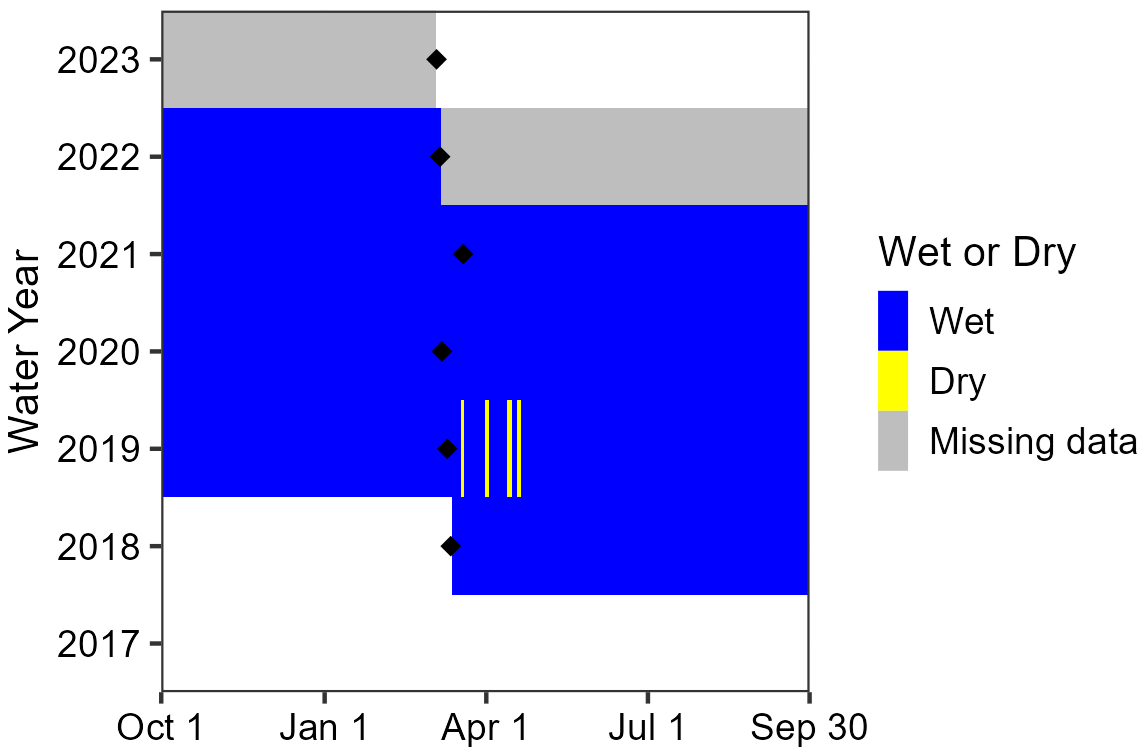
NPS
Discharge was not measured in WY2023 at the primary sampling location because the flow was too diffuse to measure. Discharge ranged from 0.6 to 0.9 L/min (0.16 to 0.24 gal/min) in 2018–2019 (Table 12).
Wetted extent was evaluated using a method for flowing water. The total springbrook length in WY2023 was 19.1 m (62.7 ft). In the past, measured springbrook length ranged from 16.5 to 43.5 m (54.1 to 142.7 ft). Width and depth along the springbrook averaged 85.1 cm (33.5 in) and 0.3 cm (0.1 in), respectively. The measured length and average width of the springbrook were within previously observed ranges, but it was shallower than in previous years (Table 13).
Water Quality
Core water quality (Table 14) and water chemistry (Table 15) data were collected at the primary sampling location in the largest pool, 6 m downstream from the orifice. Like the previous year, a syringe and calibration cup were used to collect and measure the sample for core water quality and a syringe was used to collect the sample for water chemistry, which may affect our results. Values for dissolved oxygen, specific conductivity, water temperature, and total dissolved solids were within the ranges of values recorded in prior years, while pH was higher. Levels of magnesium and potassium were within the ranges of previous measurements; alkalinity, calcium, and sulphate were lower; and chloride was slightly higher.
Upper East Grammer Spring Data Tables
| Sampling Location | WY2023 Mean (range of prior means) |
Prior Years Measured (# of visits with measurements) |
|---|---|---|
| 002 | c.n.s. (0.6–0.9) | 2018–2019 (2) |
| Measurement | WY2023 Value (range of prior values/means) |
Prior Years Measured (# of visits with measurements) |
|---|---|---|
| Width (cm) | 85.1 ± 42.2 (47.9–129.7) | 2018–2022 (5) |
| Depth (cm) | 0.3 ± 0.3 (0.9–3.0) | 2018–2022 (5) |
| Length (m) | 19.1 (16.5–43.5) | 2018–2022 (5) |
| Sampling Location | Measurement Location | Parameter | WY2023 Value (range of prior values) |
Prior Years Measured (# of measurements) |
|---|---|---|---|---|
| 001 | Center | Dissolved oxygen (mg/L) | 11.01 (6.39–11.36) |
2018–2022 (5) |
| 001 | Center | pH | 8.34 (7.46–7.85) |
2018–2022 (3) |
| 001 | Center | Specific conductivity (µS/cm) | 569 (555–601) |
2018–2022 (5) |
| 001 | Center | Temperature (°C) | 13.4 (9.0–15.7) |
2018–2022 (7) |
| 001 | Center | Total dissolved solids (mg/L) | 370.0 (361.0–390.6) |
2018–2022 (5) |
| Sampling Location | Measurement Location | Parameter | WY2023 Value (range of prior values) |
Prior Years Measured (# of measurements) |
|---|---|---|---|---|
| 001 | Center | Alkalinity (CaCO3) |
240 (270–300) |
2018–2022 (5) |
| 001 | Center | Calcium (Ca) |
16 (42–72) |
2018–2022 (5) |
| 001 | Center | Chloride (Cl) |
130 (b.d.l.–125) |
2018–2022 (5) |
| 001 | Center | Magnesium (Mg) |
39 (b.d.l.–50) |
2018–2022 (5) |
| 001 | Center | Potassium (K) |
1.4 (b.d.l.–1.9) |
2018–2022 (5) |
| 001 | Center | Sulphate (SO4) |
10 (28–53) |
2018–2022 (5) |
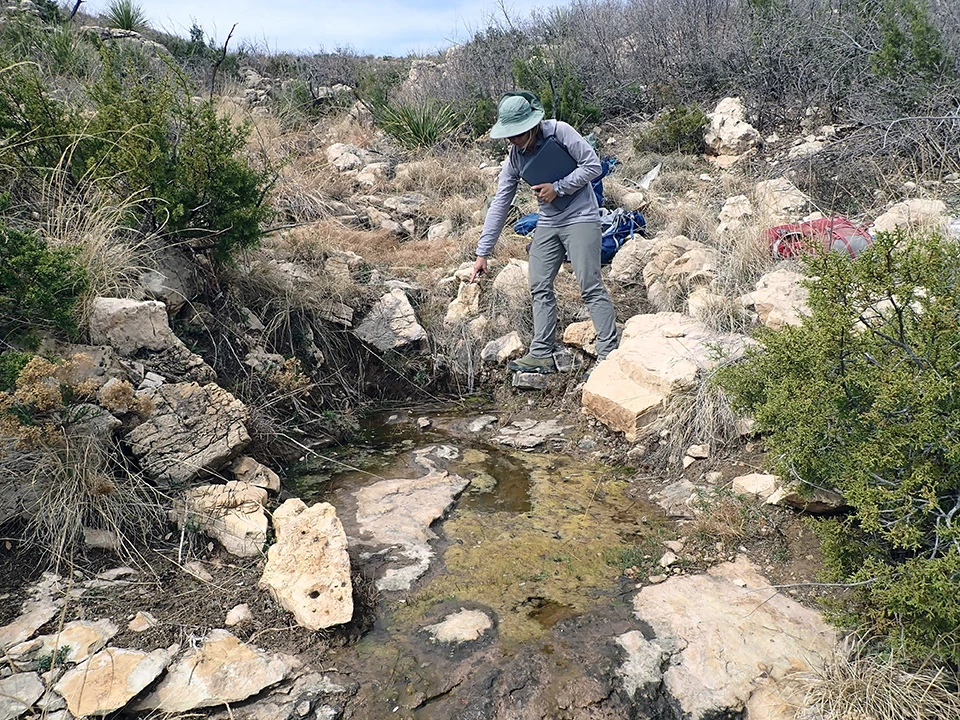
NPS
Upper Lechuguilla Spring
Upper Lechuguilla Spring (Figure 12) is a rheocrene spring (a spring that emerges into one or more stream channels) in an east-facing stretch of West Lechuguilla Canyon that trickles out from under rocks to form a shallow, intermittently wetted springbrook. The springbrook length has ranged from 3.2 to 50.5 m in length. The WY2023 visit occurred on 06 March 2023, and the spring was wetted (contained water).
Site Condition
In WY2023, we rated Upper Lechuguilla Spring slightly disturbed by wildlife based on tracks and scat in the immediate area and a javelina carcass seen near the spring (rated slightly to moderately disturbed in the past) and moderately disturbed by drying because of stressed riparian vegetation (rated undisturbed to highly disturbed in the past). No other natural or human-caused disturbances were observed at Upper Lechuguilla Spring in WY2023.
As in past years, we did not observe any invasive non-native crayfish or American bullfrog (Lithobates catesbeianus) at Upper Lechuguilla Spring in WY2023, nor did we observe any invasive non-native plants.
We observed three species of obligate/facultative wetland plants at Upper Lechuguilla Spring in WY2023: rushes (Juncaceae, observed in 2018–2022); sedges (Carex sp., observed in 2017–2022); and spikerush (Eleocharis sp., a sedge observed in 2018–2020).
Water Quantity
Sensors are deployed and data are downloaded during our annual visit, which takes place in the middle of the water year; the dates of these visits are indicated by black diamonds in the persistence graph (Figure 13). From 2018 to 2023, water persistence was monitored at orifice A. The temperature sensor indicated that Upper Lechuguilla Spring was wetted for 153 of 157 days (97.5%) measured up to the WY2023 visit. In prior water years, the spring was wetted 41.6–54.2% of the days measured across entire water years.
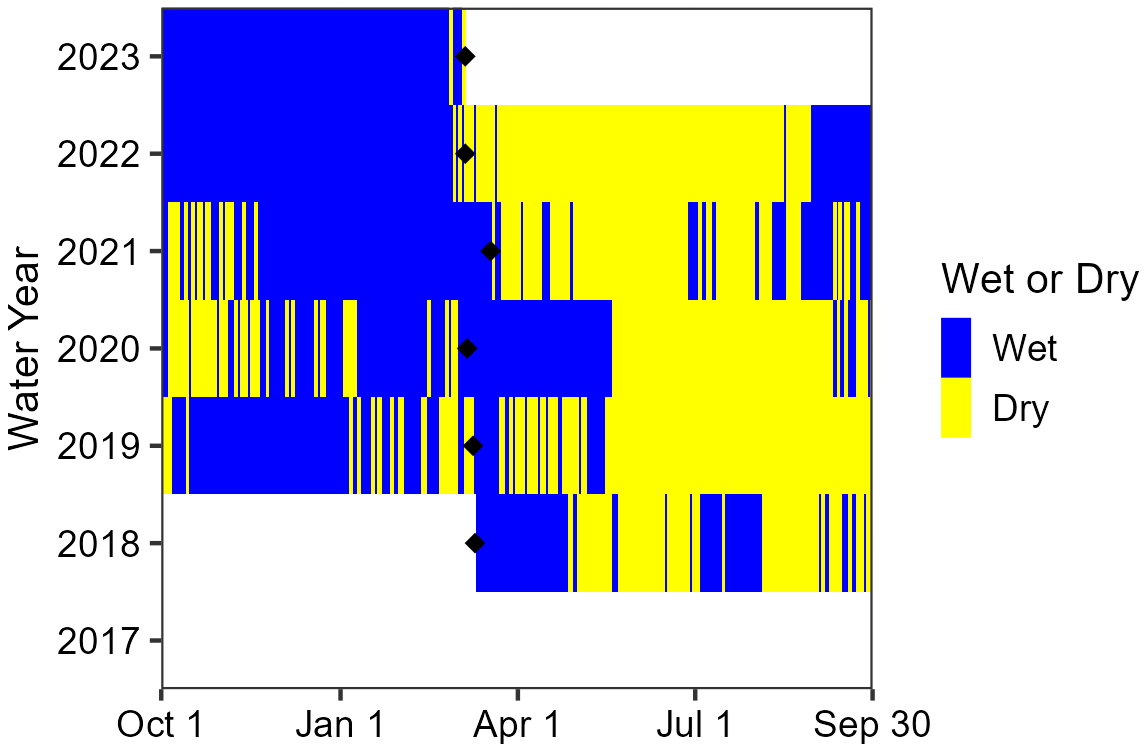
NPS
Discharge was estimated at 0.1 ± 0.02 L/min (0.03 ± 0.005 gal/min) in WY2023 (Table 16). One previous measurement is available for discharge at Upper Lechuguilla Spring (1.7 L/min in WY2020). Compared to WY2020, discharge was lower in WY2023, but additional annual monitoring is necessary to understand the normal range of values.
Wetted extent was evaluated using a method for flowing water. The total springbrook length in WY2023 was 17.4 m (57.1 ft). In the past, measured springbrook length ranged from 3.2 to 50.5 m (10.5 to 165.7 ft). Width and depth along the springbrook averaged 22.8 cm (9.0 in) and 0.5 cm (0.2 in), respectively, values that were within the range of prior measurements (Table 17).
Water Quality
Core water quality (Table 18) and water chemistry (Table 19) data were collected at the primary sampling location in the largest pool in WY2023. Because of shallow water, a syringe and calibration cup were used to collect and measure the sample for core water quality and a syringe was used to collect the sample for water chemistry, which may affect our results. Compared to previous measurements, dissolved oxygen and water temperature were higher, and pH, specific conductivity, and total dissolved solids were lower. The value for calcium was lower than the range of prior values, and alkalinity, chloride, magnesium, potassium, and sulphate were all somewhat higher than previous measurements.
Upper Lechuguilla Spring Data Tables
| Sampling Location | WY2023 Mean (range of prior means) |
Prior Years Measured (# of visits with measurements) |
|---|---|---|
| 004 | 0.1 ± 0.02 (1.7) | 2020 (1) |
| Measurement | WY2023 Value (range of prior values/means) |
Prior Years Measured (# of visits with measurements) |
|---|---|---|
| Width (cm) | 22.8 ± 36.7 (16.9–41.4) | 2018–2022 (5) |
| Depth (cm) | 0.5 ± 1.1 (0.1–1.8) | 2018–2022 (5) |
| Length (m) | 17.4 (3.2–50.5) | 2018–2022 (5) |
| Sampling Location | Measurement Location | Parameter | WY2023 Value (range of prior values) |
Prior Years Measured (# of measurements) |
|---|---|---|---|---|
| 005 | Center | Dissolved oxygen (mg/L) | 15.54 (10.40) |
2022 (1) |
| 005 | Center | pH | 7.71 (7.83) |
2022 (1) |
| 005 | Center | Specific conductivity (µS/cm) | 696 (732) |
2022 (1) |
| 005 | Center | Temperature (°C) | 16.0 (5.8–11.0) |
2021–2022 (2) |
| 005 | Center | Total dissolved solids (mg/L) | 452 (476–490) |
2021–2022 (2) |
| Sampling Location | Measurement Location | Parameter | WY2023 Value (range of prior values) |
Prior Years Measured (# of measurements) |
|---|---|---|---|---|
| 005 | Center | Alkalinity (CaCO3) |
340 (275–300) |
2021–2022 (1) |
| 005 | Center | Calcium (Ca) |
60 (78–160) |
2021–2022 (1) |
| 005 | Center | Chloride (Cl) |
11 (b.d.l.–1) |
2021–2022 (1) |
| 005 | Center | Magnesium (Mg) |
60 (15–50) |
2021–2022 (1) |
| 005 | Center | Potassium (K) |
0.2 (b.d.l.–0) |
2021–2022 (1) |
| 005 | Center | Sulphate (SO4) |
56 (31–42) |
2021–2022 (1) |
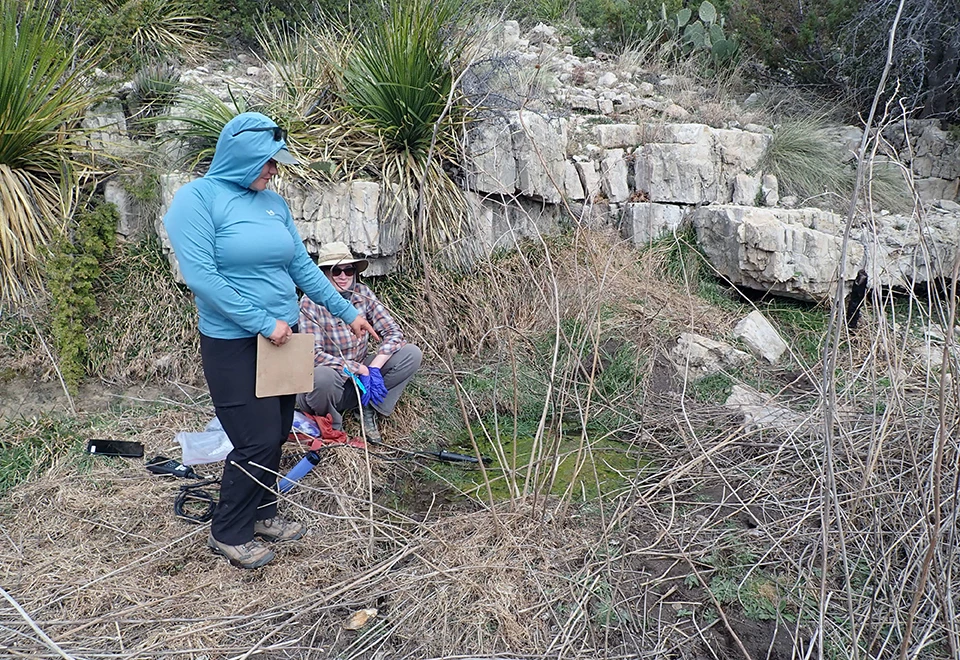
NPS
Upper Lowe Ranch Spring
Upper Lowe Ranch Spring (Figure 14) is a rheocrene spring (a spring that emerges into one or more stream channels) inside a north-facing drainage east of Rattlesnake Canyon. Multiple seeps along the base of a limestone shelf form shallow pools and saturate the soil in the immediate area. The springbrook has ranged from 2.5 m to over 100 m in length. The WY2023 visit occurred on 06 March 2023, and the spring was wetted (contained water).
Site Condition
In WY2023, we rated Upper Lowe Ranch Spring slightly disturbed by feral animals based on Barbary sheep (Ammotragus lervia) tracks and trails (rated undisturbed to moderately disturbed in the past); slightly disturbed by fire because of burned trunks in the vicinity (rated undisturbed to moderately disturbed in the past); slightly disturbed by wildlife based on tracks (rated slightly to moderately disturbed in the past); and moderately disturbed by roads/ohv trails as the Loop Road is within 200 m of the spring (rated undisturbed to slightly disturbed in the past). No other natural or human-caused disturbances were observed at Upper Lowe Ranch Spring in WY2023.
As in past years, we did not observe any invasive non-native crayfish or American bullfrog (Lithobates catesbeianus) at Upper Lowe Ranch Spring in WY2023. We observed four species of invasive non-native plants: scattered patches of marsh parsley (Cyclospermum leptophyllum, not previously observed); scattered patches of horehound (Marrubium vulgare; scattered patches observed in 2018–2022); scattered patches of Johnsongrass (Sorghum halepense; scattered patches observed in 2018–2022); and scattered patches of common mullein (Verbascum thapsus; 1–5 plants to scattered patches observed in 2018–2022).
We observed three species of obligate/facultative wetland plants at Upper Lowe Ranch Spring in WY2023: rushes (Juncaceae, observed in 2019–2021); sedges (Carex sp., not previously observed); and spikerush (Eleocharis sp., a sedge observed in 2018–2022).
Water Quantity
Sensors are deployed and data are downloaded during our annual visit, which takes place in the middle of the water year; the dates of these visits are indicated by black diamonds in the persistence graph (Figure 15). The temperature sensor indicated that Upper Lowe Ranch Spring was wetted for 157 of 157 days (100%) measured up to the WY2023 visit. In prior water years, the spring was wetted 29.9–87.1% of the days measured across entire water years.
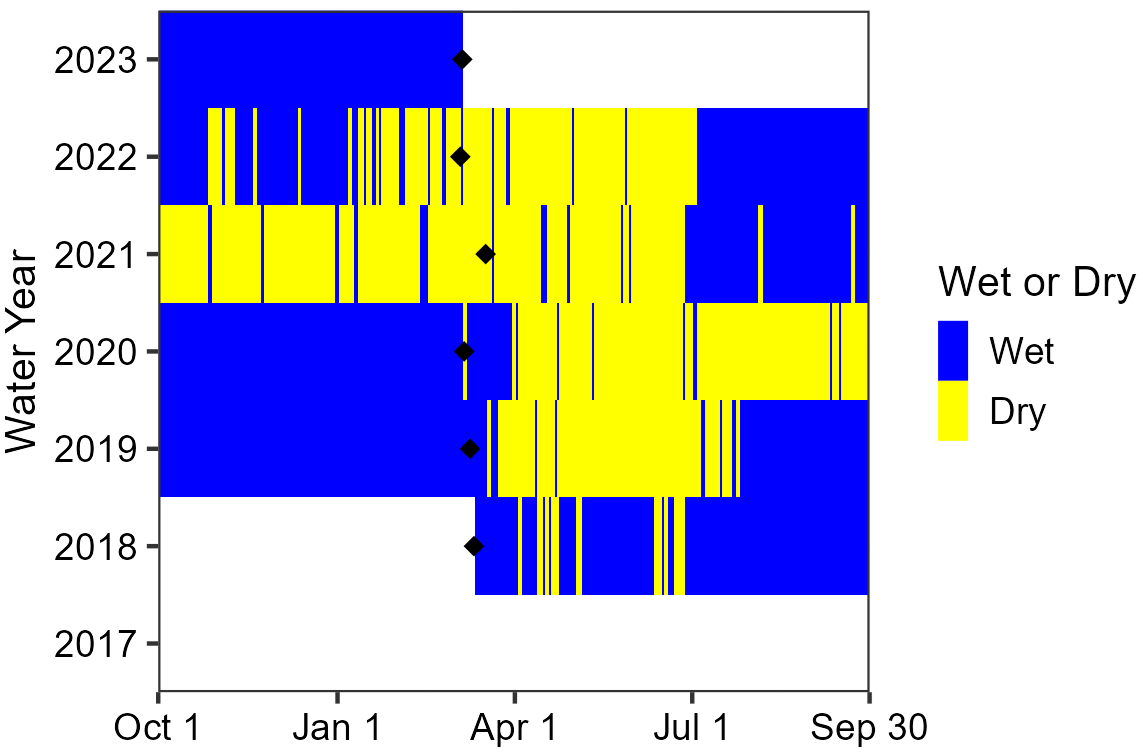
NPS
Discharge was not measured in WY2023 at the primary sampling location because of a lack of measurable surface flow. Discharge was estimated at 5.1 L/min (1.3 gal/min) in WY2020 (Table 20).
Wetted extent was evaluated using a method for flowing water. The total springbrook length in WY2023 was 9.2 m (30.2 ft). In the past, springbrook lengths ranged from 2.5 to 200 m (8.2 to 656.2 ft). Width and depth averaged 45.8 cm (18.0 in) and 2.6 cm (1.0 in), respectively. Springbrook length and average width were within the range of past values, but it was deeper than in prior years (Table 21).
Water Quality
Core water quality (Table 22) and water chemistry (Table 23) data were collected at the primary sampling location. A syringe and calibration cup were used to collect and measure the sample for core water quality and a syringe was used to collect the sample for water chemistry, which may affect our results. Values for pH, specific conductivity, water temperature, and total dissolved solids were within the ranges of prior values. The dissolved oxygen level was slightly higher than in prior years. The values for alkalinity, calcium, potassium, and sulphate were within the ranges of prior values, while chloride and magnesium were slightly lower.
Upper Lowe Ranch Spring Data Tables
| Sampling Location | WY2023 Mean (range of prior means) |
Prior Years Measured (# of visits with measurements) |
|---|---|---|
| 003 | c.n.s. (5.1) | 2020 (1) |
| Measurement | WY2023 Value (range of prior values/means) |
Prior Years Measured (# of visits with measurements) |
|---|---|---|
| Width (cm) | 45.8 ± 36.5 (42.8–164.1) | 2018–2022 (5) |
| Depth (cm) | 2.6 ± 4.5 (0.8–2.3) | 2018–2022 (5) |
| Length (m) | 9.2 (2.5–100.0) | 2018–2022 (5) |
| Sampling Location | Measurement Location | Parameter | WY2023 Value (range of prior values) |
Prior Years Measured (# of measurements) |
|---|---|---|---|---|
| 001 | Center | Dissolved oxygen (mg/L) | 14.65 (4.11–12.91) |
2019–2022 (5) |
| 001 | Center | pH | 8.00 (7.57–8.39) |
2018–2022 (6) |
| 001 | Center | Specific conductivity (µS/cm) | 517 (506–582) |
2018–2022 (6) |
| 001 | Center | Temperature (°C) | 17.3 (10.4–22.3) |
2018–2022 (9) |
| 001 | Center | Total dissolved solids (mg/L) | 336 (329–378) |
2018–2022 (6) |
| Sampling Location | Measurement Location | Parameter | WY2023 Value (range of prior values) |
Prior Years Measured (# of measurements) |
|---|---|---|---|---|
| 001 | Center | Alkalinity (CaCO3) |
240 (225–295) |
2018–2022 (5) |
| 001 | Center | Calcium (Ca) |
64 (52–64) |
2018–2022 (5) |
| 001 | Center | Chloride (Cl) |
0 (4–265) |
2018–2022 (5) |
| 001 | Center | Magnesium (Mg) |
34 (36–65) |
2018–2022 (5) |
| 001 | Center | Potassium (K) |
0.3 (0.0–1.3) |
2018–2022 (5) |
| 001 | Center | Sulphate (SO4) |
0 (0–8) |
2018–2022 (5) |
Report Citation
Authors: Susan Singley, Kara Raymond
Singley, S., and K. Raymond. 2025. Climate and Water Monitoring at Carlsbad Caverns National Park: Water Year 2023. Chihuahuan Desert Network, National Park Service, Las Cruces, New Mexico.
